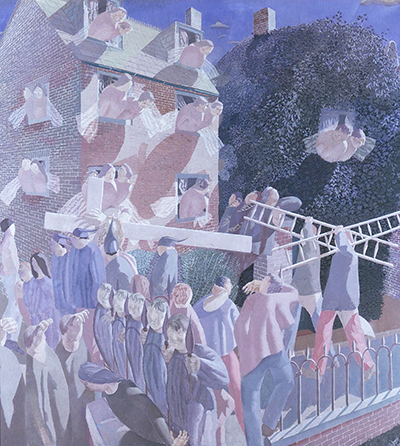Spencer uses his beloved Cookham in England as the scene Christ Carrying the Cross. His aesthetically pleasing use of light colours may be a tip of his hat to the village.
One could argue he intentionally used bright pastels to show the town in a light-hearted manner. This use of colour is in complete contrast to the darkness of the subject matter, a crucifixion. Christ Carrying the Cross lays bare the complexity of Spencer's vision and talent. Using the medium of oil on canvas, Spencer puts his brushes to work in a smooth and studied way. Each figure in the painting is infused with a melancholy that has a hint of joy attached in a way only he could encapsulate. His use of lighter shades disguises the sadness of the picture. By doing so, Spencer stimulates the viewers' sense of feeling as well as his sense of light.
Taking a closer look at the picture, one would be mistaken for thinking the men carrying ladders are part of the crucifixion procession. However, Spencer revealed their true meaning in a conversation at an exhibition in the 1950s. While working on the artwork, 'he saw two workmen carrying ladders in the village and added them to the painting to add a sense of realism'. One could even mention the word 'cubist', and it would not sound out of place with this painting. Looking at figures in the painting one could easily judge the style as a nod to cubist ideas even though Spencer never mentioned he had any inkling that he was open to such persuasion.
Included in the work is the artist's house in Cookham, while the ivy-covered building is his grandmother's house. By painting these buildings into the scene, he adds more cement to the idea that he had more than just a passing love of all things Cookham. For instance, in 1927, he presented 'The Resurrection, Cookham' to Lord Duveen. This expressive work depicted the resurrection of Christ, with Cookham churchyard as the central location. An art critic at the time labelled the painting as one of the most important pictures by a British artist this century. With accolades like this, Spencer's work on Christ Carrying the Cross must be viewed in the same context and considered to be the forerunner of his most significant work.




